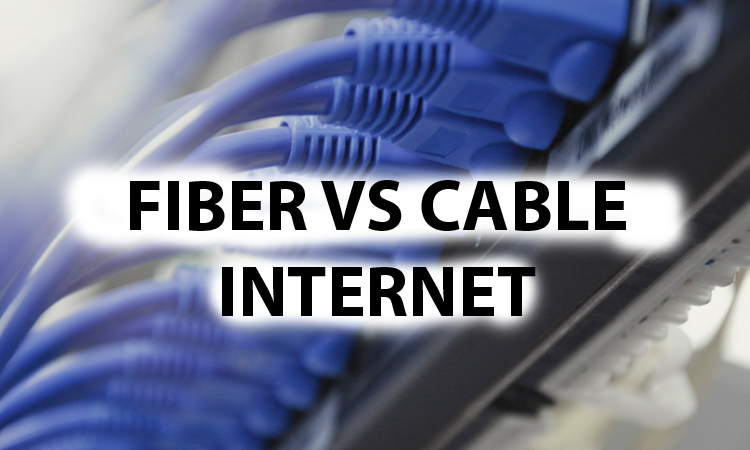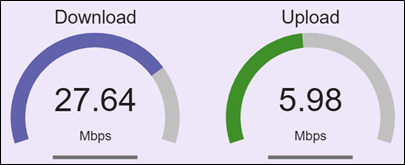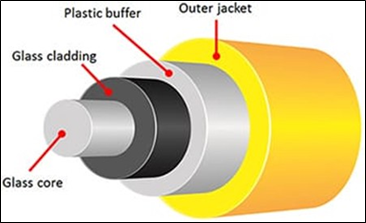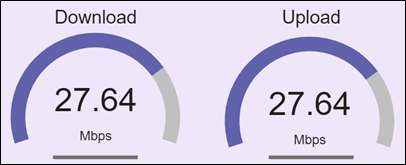
Not so long ago, the Internet was only delivered over copper cables. Service provisioning was slow, and speeds were limited. Connecting to the Internet meant having to wait for a dial-up connection to be set up. Speeds were a measly 64 kbps or less. On top of that, the phone line could only be used for either making calls or for using the Internet.
That’s not true anymore. Multiple high-speed options are available today for those looking for reliable Internet connections. These include fiber, cable, T1, satellite, and fixed wireless. And let’s not forget LTE and 5G!
The Internet is everywhere. If you are at home, on the move, in the air, or even underground, there is a technology or combination of technologies that will get you a high-speed connection to the Internet.
There is no technology that is better than another. This is because each technology has its own characteristics. The qualities of each technological offering makes it more suitable for certain situations and less suitable for others.
For example, if you are in a remote desert or on a cruise liner, then satellite Internet is the only realistic option. If you live on a mountain top, then fixed wireless could solve your problem.
However, if you live in a city, then most likely you would consider Internet over cable or fiber because of its availability, high speeds, and reasonable cost.
What is Cable?
Cable refers to a coaxial cable which is a type of cable with a solid inner conductor made of copper that is surrounded by a conducting shield. The conductor and the shield are separated by an insulating material. The conducting shield is grounded to minimize the effects of electromagnetic interference. The cable is covered with an outer jacket to provide protection from the environment.
Coaxial cables are available in a variety of sizes. The cost of the cable increases as the thickness of the inner conductor increases. Thicker cables are also heavier but can carry signals for longer distances without requiring amplification.
Cable can be used for transmission in a variety of applications such as cable TV, broadband Internet, and data networking. The physical cable from the service provider terminates on a cable modem installed at your location. The cable modem has interfaces that connect to your Wi-Fi router, network router, or television set.

Figure 1: Coaxial cable
How Fast is Cable Internet?
Cable supports downlink (service provider to user) data rates of 10 to 1000 Mbps, and uplink (user to service provider) data rates of 5 to 50 Mbps. Internet service over cable is usually shared between multiple users. This means that you might experience slow speeds during peak traffic times such as early morning or late night.
Is Asymmetric Bandwidth Okay?
Most methods of delivering Internet for business and residential users including cable are designed with asymmetric data delivery. The downlink data rates are much higher than the uplink data rates. This asymmetric design is actually based on user requirements. When most of us use the Internet, we pull a lot more data from the Internet and push comparatively a lot less data back onto it.

Figure 2: Asymmetric bandwidth
Example
Consider a simple example: you type a website name in the browser window and the webpage loads in few seconds. The website name is the request that you send, and the webpage is the response that you get. The webpage will be comprised of text, images, and may also contain embedded videos. For a numerical comparison, the size of the request you send is a few kilobytes, and the webpage could be 2 to 3 megabytes in size.
Consider another example: you want to see a YouTube video, and you send a request, and the video starts playing and keeps on playing for 10 minutes or an hour. Again, if we do a numerical comparison, the request sent by you is a few kilobytes in size, and the response from the Internet could go up to several hundred megabytes in size.
Keeping this in mind, it would not make sense to make the uplink and downlink rates equal as most of the uplink would get wasted. It makes much more sense to have uplink and downlink capacities that closely model actual traffic requirements.
Cable Internet, like DSL and LTE, is also designed with asymmetric bandwidth provisioning. The asymmetric nature of cable Internet is perfectly ok for the majority of users. This is because, depending on your service plan, you can get 5 to 50 Mbps uplink data rates which is more than sufficient for most applications.
How to Setup Cable Internet
Cable Internet works over coaxial cables. You have most likely used Cable TV service in the past. This same cable can be used for Internet service. In fact, most service providers now offer both TV and Internet services over their cable networks.
If you are already using cable TV service and want to use the Internet over the same cable, then you have to send a request to the service provider to enable your Internet service. After Internet service is enabled, the cable that was previously connected to the TV will now be connected to a cable modem. The cable modem will have an output interface for TV connection and Ethernet interfaces so that you can connect your laptop or Wi-Fi router. In this way, you will be able to use both the Internet service and the cable TV service simultaneously.
If you want a new cable connection, then the service provider might opt for a site survey to determine the cable lengths and equipment required for the connection. A technician from the service provider will install the cable and the cable modem. You can then connect your home/office network to the cable modem and start using the services.
With cable, it is much easier to do a self-install especially if you have been using cable Internet or TV services previously. A self-install is also going to cost less.
What is Hybrid Fiber-Coax (HFC)?
You should know that in cable network terminology, a headend is the main site where all TV signals are received then distributed over a cable TV system.
The network architecture typically used by cable operators is known as Hybrid Fiber-Coax or HFC. As fiber has a higher data-carrying capacity, this network architecture uses fiber connections for the high-capacity links that extend from the service provider’s headend to the regional headend and to neighborhood hub sites. The service distribution within the neighborhood is done over cable.
Here is a basic comparison of the pros and cons of cable Internet:
Pros of Cable
- Availability
- Fast speeds
- Reliable
- Internet and TV over the same cable
Cons of Cable
- Shared bandwidth
- Asymmetric bandwidth
What is Fiber?
Fiber refers to the use of fiber optic cables for the transmission of multimedia services. The main information-carrying part of the fiber is a transparent core which is surrounded by cladding that has a lower index of refraction. This arrangement ensures that the light stays in the core as it passes through the cable. The core is made of glass or plastic. The fibers are coated with plastic layers and surrounded by a protective jacket that varies with the environment where the cable will be used.
Even though it is possible to have just one fiber in a cable, fiber optic cables are usually made with multiple fibers within the same cable. This is done so that the service provider has room for future expansions.
Pulses of light are used to carry digital information through fiber optic cables. The infrared light used for fiber communication is not safe for the human eye. For this reason, looking straight into a fiber cable without suitable protective eye gear is not recommended!

Figure 3: Fiber optic cable construction
-
Multi-mode fiber
Multi-mode fiber cables have a larger core diameter. They can be used for data transmission over distances of up to 2 km (i.e. within a building or on campus.) The equipment used for multi-mode fiber transmission and the fiber cables themselves are less expensive than single-mode fiber.
-
Single-mode fiber
Single-mode fiber cables have a smaller core diameter. They can be used for data transmission over distances of up to 40 km. The equipment used for single-mode fiber transmission and the fiber cables are more expensive than multi-mode fiber.
How Fast is Internet Over Fiber?
Data transmission over fiber is not limited by the fiber itself. It is limited only by the capability of transmission equipment connected to the fiber. The undersea fiber cables that carry data between continents support multi-terabit (1 Terabit = 1000 gigabits) data rates.
Service providers of commercial Internet over fiber offer Internet speeds of up to 2 Gigabits.
Fiber vs Cable Internet: What’s the Big Deal about Symmetric Bandwidth?
Fiber service providers usually provision symmetric Internet service. This means that the downlink data rate is equal to the uplink data rate. If you are constantly using applications that send a lot of bandwidth towards the Internet such as video conferencing, gaming, video surveillance, high-capacity data backups, etc, then symmetric bandwidth is what you need.

Figure 4: Symmetric bandwidth
This is especially relevant in the current global scenario with many students taking video-based classes from home and employees working from home or from other remote locations. In the current global climate, having a stable high-speed Internet connection with smooth video performance is critical.
This is where fiber totally outdoes the competition. Most other forms of Internet service provisioning are done with asymmetric bandwidth. Services such as cable, satellite, DSL, and LTE are all designed with uplink data rates that are much less than the downlink data rates.
How to Setup Fiber Internet
With fiber, it is recommended to always opt for a professional install as most buildings lack fiber infrastructure. This will make the setup cost of fiber a bit expensive. However, a professional install will pay off in the long term. Equipment and cables that are properly installed are less likely to develop faults and are also less likely to require maintenance.
The first step is to find a fiber Internet service provider in your area. Once you have made the selection, the service provider might opt for a site survey to determine the exact cable lengths and equipment that would be required for a proper installation.
During the installation, a technician will install an optical network terminal (ONT) or terminate the fiber directly onto a router with a fiber interface. The function of the ONT is to convert optical signals on the fiber to electrical signals that you can use. You can either purchase a router or lease it from the service provider. In any case, we encourage going with a provider-recommended router so that there are no compatibility issues.
Once the technician has checked the fiber connection, you can connect your home/office Wi-Fi or wired LAN setup to the router and start using the Internet.
Fiber to the X: What?!
Fiber to the X or FTTX is a generalization for several fiber deployment configurations including FTTH, FTTC, and FTTB.
- Fiber to the Home (FTTH): a fiber optic cable terminates on an ONT installed at your house or office. This deployment model is becoming more and more common as people opt for fiber to satisfy their ever-increasing bandwidth needs.
- Fiber to the Curb (FTTC): a fiber node is installed on a pole or a closet. DSL lines or cable are used for delivering service to the users’ locations.
- Fiber to the Building (FTTB): one fiber node is installed inside a building. All the users in that building can be connected to the fiber node over Ethernet cables or coaxial cables.
- Fiber to the Node/Neighborhood (FTTN): a fiber node is installed in a neighborhood. The connections from the fiber node to the users’ homes and offices are provisioned over DSL or cable.
Fiber vs Cable Internet: Is Fiber Faster than Cable?
Fiber is not only faster than cable, it is faster than any other medium that has been invented to date!
Let’s compare maximum speeds for all the transmission media that are being used today:
- Fiber: 319 Terabits per second (1 Terabit = 1000 Gigabits)
- Cable: 1000 Megabits per second
- Satellite: 100 Megabits per second
- DSL: 100 Megabits per second
- Fixed wireless: 1000 Megabits per second
The figure quoted above for fiber is a record that was recently achieved for fiber transmission. This much capacity is not required by any single household or business, so you won’t find anyone offering it even if you ask for it. The figures quoted above for the other media are commercially available data rates: you can get them if you can afford them.
But one question that you shouldn’t ask again is: “Is fiber faster than cable?”. The simple answer is that it is faster than everything else.
Is Fiber Internet Better than Cable?
The answer to this question is: it depends.
- Speed: Fiber is faster than cable. Period!
- Availability: As per the FCC, fiber availability lags significantly behind that of cable. As of early 2018, only 14% of the US was covered by fiber whereas cable had 88% national coverage. There is no doubt that fiber rollouts are in progress, and the current fiber coverage has improved. But fiber still can’t match cable when it comes to availability. Most fiber Internet service providers require that you visit their website and check service availability for your address.
-
Fiber vs Cable Internet Cost:
- The short-term cost of fiber – for both the equipment and the bandwidth – is higher. However, fiber is cheaper over the long term. This is because fiber is future-proof and can handle your current and future bandwidth requirements. Using a cheaper alternative for now, and upgrading to fiber later will cost much more over the long term.
- Maintenance: fiber has a lower maintenance cost compared to cable.
- Interference: coaxial cable is designed with a grounded outer conductor to reduce electromagnetic interference, but it is still not immune to interference. Fiber on the other hand uses pulses of light for data transmission and is completely immune to electromagnetic interference. This also makes fiber inherently more secure as connections cannot be tapped.
- Distance: if your home/office is far away from a service provider’s infrastructure, then it is easier to use fiber for your connection as it can cover far longer distances compared to cable. Fiber connections can cover up to 25 km easily whereas cable connections would require the use of multiple repeaters/amplifiers to cover much smaller distances.
- Cable size: fiber speed is not connected to the cable size or weight. On the other hand, larger and therefore heavier coaxial cable sizes may need to be used to cover longer distances and or high speeds. Therefore, fiber is easier to install and handle when compared to bulkier coaxial cables used for cable service.
- Reliability: fiber is more reliable as less equipment is required for a fiber network compared to a cable network. Less equipment translates to fewer points of failure, and consequently, to fewer faults. The fiber itself and accessories such as cables, splitters, ONTs, etc. are not made of metal. Therefore, they do not contain components that are susceptible to rusting. Fiber does not carry a current, so there is also no fire hazard. Cable on the other hand carries a very low current: even though it is not enough to cause a fire on its own, it is not as fire-proof as fiber.
Who are the Best Fiber Internet Providers?
Several providers are offering fiber Internet services.
- Google Fiber is available in 11 cities across the continental USA. Speeds of up to 2 Gbps are available. You need to enter your address on the website to check if the service is available at your location. The service is available for $70/month. A phone line can be added for a further $10/month. Free Wi-Fi is also provided with the plan.
- Verizon Fios fiber service is available in 11 metropolitan areas with speeds of up to 1 Gbps. The availability for each location has to be checked through the website. Verizon offers multiple plans:
- Gigabit speed, $89.99/month, 2 TB cloud storage included,
- 500 Mbps, $64.99/month,
- 300 Mbps, $39.99/month
- AT&T fiber service is available in multiple cities. Availability of the service has to be checked through AT&T’s website. Two plans are available:
- 300 Mbps: $35/month
- 500 Mbps: $45/month.
- CenturyLink offers 1 Gbps fiber Internet in 21 metropolitan areas. The service is available for $65/month.
Here are some of the pros and cons of fiber-based internet:
Pros of Fiber
- Speeds of up to 2 Gbps
- Symmetric bandwidth
- Higher reliability
- Immune to interference
Cons of Fiber
- Limited availability
- More expensive
- Limited plans
Both cable and fiber offer blazing fast Internet speeds. At present, the footprint of cable is much larger as it’s an established technology. Fiber is the new kid on the block, and its coverage does not match that of cable, but it is increasing steadily.
When it comes to speed, nothing can match fiber. Plus, you also get symmetrical bandwidth which is great if you are using video a lot as video has a higher uplink data rate requirement.
Fiber is also future-proof. Our bandwidth requirements are continuously increasing as we go from HD to 4K to 8K, and the same fiber connection will be able to handle all our future needs. Fiber is slightly more expensive, but we expect that to decrease in the near future.
With insight, decision-making is easier and has higher chances of success.
We hope that we have been able to offer insight that will help you in deciding which internet service is the best for you.
For more information about adding cable vs fiber internet to your office, contact us for a free quote. We look forward to working with you! We also provide businesses with high-quality phone systems and other telecom services.

